If you plan to invest in the cryptocurrency world, please take a few minutes to read this carefully, as it may save your life and your family.
Thousands of originally happy families end up broken and bereaved, which stems from the pursuit of an unattainable dream of making a fortune in the cryptocurrency world.
I think the reason I can continue on the trading path is that I have been diligently learning, not only understanding the basic knowledge, analyzing news, but also studying technical indicators. And the formation of my self-stabilizing profitable trading system!
Tested method: My cryptocurrency trading method is very simple and practical, and I reached an eight-digit figure in just one year, doing only one pattern, entering the market only when the opportunity is right, and not trading without a pattern. I have maintained a win rate of over 90% for five years!
More time is spent fishing and exercising. From entering the cryptocurrency market with 50,000 to making 10 million, then to being 8 million in debt, then making 20 million, and now reaching financial freedom. In the past two years, from May 24, 2022, to November 10, 2024, in less than two years, starting with less than 500,000, I achieved a return rate of 1,006,626%, making over 45 million. I want to give some practical and useful advice to those new to the cryptocurrency market!
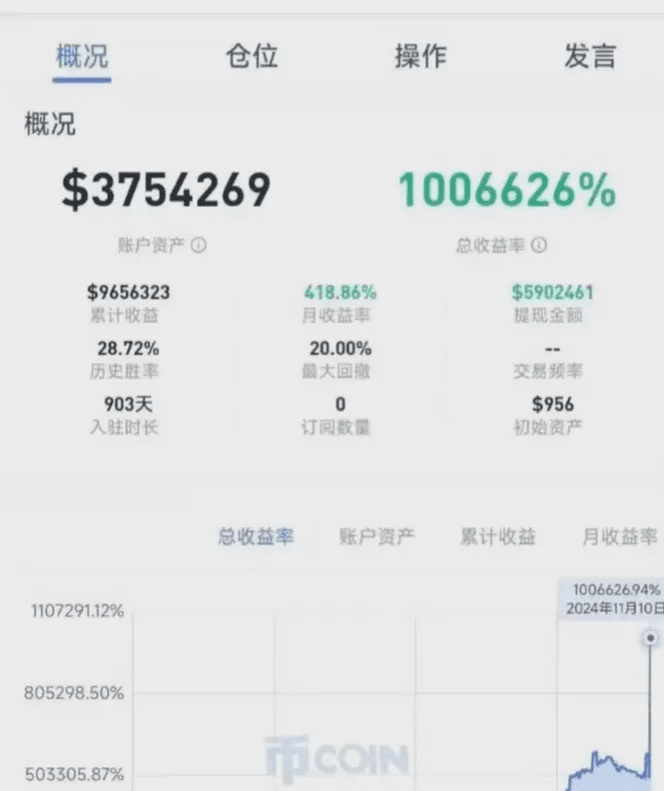
A single move from 500,000 to millions! This is the simplest cryptocurrency trading method, 11 pieces of trading insights that everyone can use.
1. Observe after high and low consolidation.
When the market is in a high or low horizontal consolidation phase, observing is a more cautious strategy. The appearance of horizontal consolidation often precedes a market shift. After digesting previous fluctuations, the market will eventually choose a clear direction. At this time, taking impulsive actions may lead to unnecessary losses. Wait for the market to clarify, and only then act in accordance with the trend.
2. Do not cling to hot positions; adjust positions with the market.
In short-term operations, popular positions are often the result of speculation. Once the heat dissipates, funds will quickly exit, leaving investors trapped in a passive situation. Therefore, the elder suggests not to linger too long on popular positions but to adjust flexibly and maintain agility. As he said, "Short-term popular positions come quickly and go quickly; a little carelessness can lead to chasing highs and cutting lows. Successful short-term operations are not about blindly following but about staying alert and achieving 'from start to finish, only to end up empty.'"
3. Rising trend with a gap up, holding positions must be firm.
If a bullish candle with a gap up appears during an upward trend and is accompanied by increased volume, it indicates that the market has entered an accelerated upward stage. At this time, one should remain calm and hold positions firmly, as such situations often lead to significant rises. The elder refers to this as the "acceleration period," emphasizing that during this stage, one needs to be firm in belief and not be affected by short-term fluctuations to achieve substantial profits.
4. A massive bullish candle must lead to a decisive exit.
Regardless of whether the market is at a high or low position, a massive bullish candle is always a signal to exit. In such cases, even if you see a limit-up, you should decisively close positions because, in most cases, a massive bullish candle will be followed by a pullback. The elder told us, "No matter how enticing the profit is, taking what you have and decisively closing positions is key to avoiding profit withdrawal." The core of this strategy lies in knowing when to enter and exit, always guarding against risks and controlling returns from drawdown.
5. Buy on the upward moving average with a bearish candle, sell on the downward moving average with a bullish candle
Moving averages are one of the key references for short-term operations. If the stock price is above important moving averages and a bearish candle appears, it is a suitable buy signal; conversely, a bullish candle below the moving average may indicate weak upward momentum, making it suitable for selling. In short-term investments, generally only daily moving averages or attack lines should be focused on; it is unwise to hold positions for too long. The elder reminds us, "No more than a week, act within three days; don’t linger on missed opportunities." Short-term trading emphasizes speed and accuracy; holding for too long increases risk.
6. Do not sell high, do not buy on dips, and do not trade in horizontal markets.
In the cryptocurrency market, frequent fluctuations are regarded as the basic survival principle. If the current price is not significantly higher than the buy-in price, one should not easily sell; conversely, if there is no significant drop, do not rush to buy. When the market is in a horizontal state, observing is safer. The elder calls this 'steady as the priority.' Any hasty trades may lead to losses. Long-term profitability relies not on frequent entries and exits but on reasonable timing for entry and exit.
7. Enter less, do not enter more, act according to one's ability.
In the cryptocurrency sphere, ensuring flexibility is key. Even with great confidence, avoid investing large sums at once; reasonable diversification is particularly important. The elder reminds us, "Better to enter less than to be greedy," as unexpected market fluctuations can occur at any time. Diversifying funds can reduce risks from any single investment. For every trade, establish reasonable position ratios so that you won't be caught off guard in the event of sudden market movements.
8. Learn to interpret market news.
In the cryptocurrency sphere, the influence of news cannot be underestimated. Market news often directly triggers significant price fluctuations, which could lead to large increases or decreases. Therefore, investors should learn to interpret market information, especially regarding major events and policies. The elder suggests that beginners should primarily observe when encountering significant news, as excessive intervention may lead to unnecessary losses.
9. Master technical indicator analysis.
Technical analysis plays an important role in the cryptocurrency market. The elder suggests that beginners should systematically learn technical indicators, formulate learning plans, and master analysis tools such as moving averages, KDJ, Bollinger Bands, candlestick patterns, volume-price relationships, and capital flow. Technical analysis requires long-term accumulation and is not achieved overnight. Mastering technical analysis can help investors judge entry and exit points, reducing unnecessary losses.
10. Formulate a trading plan to avoid frequent trading.
Frequent trading not only incurs high fees but also disturbs the trading mindset, leading to emotional operations. The elder emphasized, "Trading requires planning; it cannot be blind or arbitrary." In the cryptocurrency sphere, frequent entries and exits often mean greater uncertainty. An effective trading plan can help investors maintain rationality and clarity of thought.
11. Implement risk control, set stop-loss and take-profit points.
Before every trade, set reasonable stop-loss and take-profit points, keeping risks within acceptable limits. When reaching stop-loss or take-profit points, one should decisively exit instead of greedily continuing to pursue profits. Price fluctuations in the cryptocurrency market are severe, and the elder's experience tells us, "Reasonable stop-loss and take-profit are keys to successful trading." Even experienced investors cannot accurately predict the market, thus effective risk control measures are essential for every investor.

Advice for newcomers to the cryptocurrency sphere, stemming from a lesson learned from one million.
1. Investment should not be obsessive; obsession with the asset will distort operations.
Analysis of the reasons for easily forming obsessions: suffering huge losses on the asset; selling after a rebound leads to missed opportunities, while friends around gain huge profits; the narrative surrounding the asset continues to heat up, leading to profits from re-establishing positions but getting trapped; repeatedly fluctuating around the cost leads to being deeply trapped; after being trapped, unable to cut losses, and fearing the return of a price surge; increasing sunk costs leads to an overall imbalance in investment operations. A better approach is to decisively cut losses in a timely manner or forget about this portion of assets and wait for a cycle to rotate; any operation that helps restore a calm mind is positive.
2. Do not go against the trend; the great eagle soars on the wind, rising ten thousand miles.
Looking back at the first wave of market trends this year, the most vigorous sectors were: BTC, AI, MEME; during the most dismal phase from April to September, despite the prevailing anti-VC sentiment, many memes still emerged. Although inscriptions are essentially a sub-branch of memes, they belong to the Bitcoin ecosystem. With the issuance of tokens by the Merlin project, the Bitcoin ecosystem is reaching its twilight, followed by a liquidity shortage. The SOL ecosystem is booming, and the AI + CRYPTO narrative has reached a climax, showing signs of recreating the DeFi summer trend; holding onto garbage assets takes up positions and lags far behind the market gains. Hold good Beta assets and seek Alpha assets (main narratives).
3. Do not use leverage; leverage increases capital efficiency but also opens the door to desire.
Position management is the core of investment. After thorough research on the asset, how much to bet and analyze the risk-reward ratio should all be within the strategy's rhythm. The emergence of leverage amplifies volatility and brings risks of liquidation, severely testing one's trend judgment, entry positions, and psychological pressure. Mid-year this year, due to high expectations for the market, to alleviate capital occupation, I pledged tokens to enhance liquidity in hopes of gaining more profit. However, at the wrong time, I made the wrong move, putting myself in a secondary trading position, resulting in significant drawdowns. Most people fantasize about becoming the chosen ones, but we must accept the reality that we are ordinary people. On the investment path, surviving is the only way to go further.
4. Do not compare; comparison is the source of all unhappiness.
In the era of studying, comparing academic performance; in adulthood, comparing marriage and career; in old age, comparing family status. Most people's lives revolve around comparison. I used to feel anxious about who broke through A8 or A9, or who grabbed the opportunity to make a million dollars with a coin. However, after some thought, I realized that happiness is personal, and sadness is personal. Investment requires introspection, focusing more on oneself, cognition, systems, strategies, and execution. Strive to become a better self at every step and enjoy the results of the present.
5. Recognize the boundaries of your abilities; operate within the limits.
Look inward, recognize yourself; opportunities are always occurring. Missing them is not worth regretting. There are certainly people who win big with mixed colors in Texas Hold'em, but just watch. Wait for opportunities within your capacity to arise; only then can you place heavy bets and hold onto them.
6. Refuse to consume, guard your moral heart.
Thoughts driven by quick gains consume emotions and only disrupt judgment and ruin one's morality. I have learned to refuse; recently, I have started to play tennis and run for fitness.
From losing 8 million to currently having over 200 million, mastering the wealth password technology—mastering the technical indicators MA and MACD. Once learned, it is easy to make millions! (Pure content, suitable for everyone, easy to learn, and straightforward.)

1. Explanation and application of MA moving average indicators.
The MA indicator, also known as Moving Average, calculates the average price within its numerical scope. For example, MA5 represents the average price of the last 5 time periods (including the current one) in the candlestick chart, regardless of whether it is minute-level, hourly-level, or daily-level. The smaller the MA number, the more sensitive it is to fluctuations, focusing more on short-term movements; conversely, the larger the MA number, the slower the fluctuations, focusing on long-term movements.
The numbers for MA can be set according to personal preference. Here, I share two sets of MA trading methods that I commonly use, namely the Vegas channel and the squeeze channel.
Vegas channel
The Vegas channel, in simple terms, utilizes the 144 and 169 moving averages to judge medium to long-term trends. This method is not suitable for periods shorter than 15 minutes, but is applicable for periods longer than 1 hour.
Why use these two moving averages?
By careful observation, we can see that 144 and 169 are the squares of 12 and 13 respectively. The principle subtly contains Gann's square theory and the Fibonacci sequence. That is, the number 144 comes from Gann's square theory, while the number 169 is the square of the Fibonacci number 13. Only when these two are combined can they yield better practical application results.
Example explanation:
Taking the 4-hour trend of OP as an example, we find that when the 144-day moving average crosses above the 169-day moving average, a golden cross forms (the golden cross indicates that the 144 moving average crosses above the 169 moving average), indicating a bullish outlook in the medium to long term, and one can consider entering. When the price reaches the top, the 144 moving average crosses below the 169 moving average, forming a death cross (the death cross indicates that the 144 moving average crosses below the 169 moving average), suggesting a watchful exit in the medium to long term.
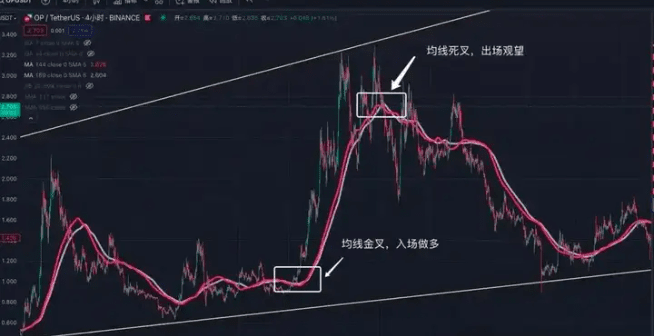
Some might ask, your statement seems too absolute. How do you explain the back-and-forth golden crosses and death crosses of moving averages before the horizontal state? This is just gambling!
Here, my suggestion is that since the 144 moving average and the 169 moving average cannot determine short-term trends due to their strong lag, additional 7 and 14-day moving averages can be added for auxiliary judgment. Let's enlarge the trend of OP and judge medium to long-term market changes through large-scale MA moving averages, then confirm through small-scale MA golden crosses.
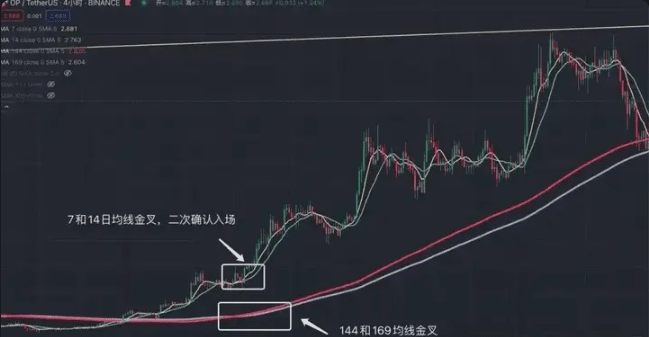
The Vegas channel is used to judge medium to long-term trends. Due to the lagging nature of the Vegas channel, it still requires pairing with short-term moving averages for auxiliary verification. A strong market trend must see the 144 and 169 moving averages rising. If the price hovers around the 144 and 169 moving averages, it indicates that the short-term market is weak, making it unsuitable for entry. At the same time, the 144 and 169 moving averages provide good support and resistance, making them suitable for ultra-short-term rebound operations.
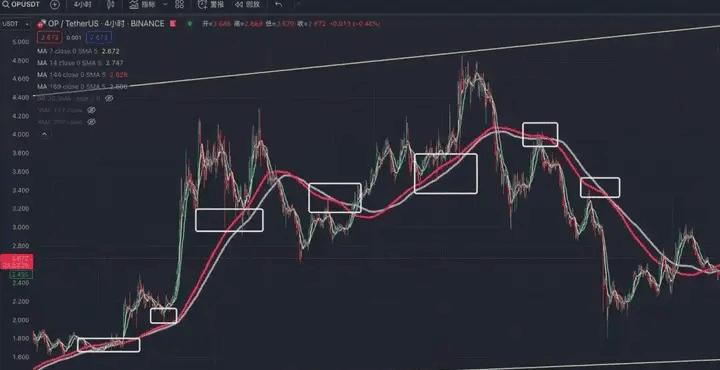
Squeeze channel
The squeeze channel primarily originates from the squeeze theorem in mathematical calculus. Simplistically, if a function is 'squeezed' by two other functions near a certain point, and both of those functions approach the same limit, then the limit of the squeezed function will also approach the same value.
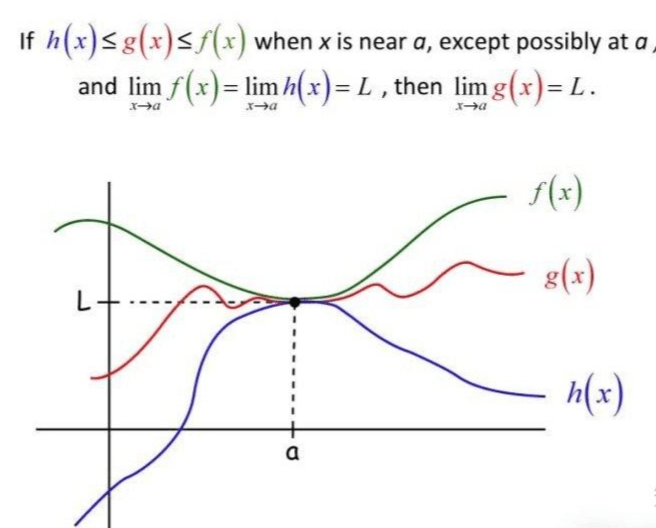
In secondary market trading, we can also apply a similar squeezing theorem model. We can simplify to two moving averages, 111 and 350. Since the 350 moving average has a longer period, it is recommended to use it in short-term trading.
Why these two moving averages?
Dividing 350 by the 111 moving average gives us a number that closely resembles pi, which is 3.15, or we can say that dividing 350 by 3.14 gives us the closest number to 111.
Example explanation:
Taking the 1-hour trend of TRB as an example, when the blue line (350) is above, and the yellow line (111) is below, forming a similar or near triangular shape, it indicates a successful "squeeze." After success, the subsequent trend looks bullish, but it is necessary to note that for a correct "squeeze" formation, the 111 moving average must cross above the 350 moving average. If only one side crosses, it does not establish.
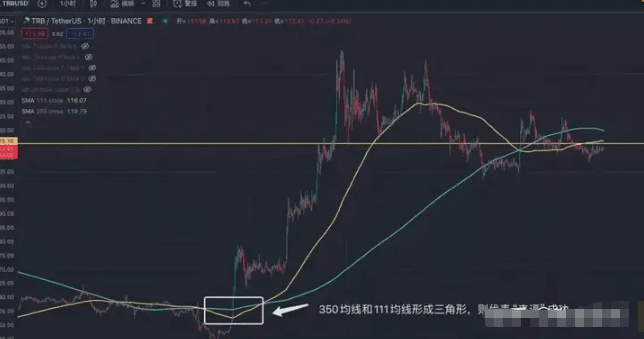
This channel is suitable for 1-hour and 4-hour levels, but the accuracy is generally low. However, once successful, the subsequent trend will be a large-scale market trend. Therefore, when a squeezing formation occurs, one should pay more attention and monitor it closely. We can also use other technical indicators for auxiliary judgment.
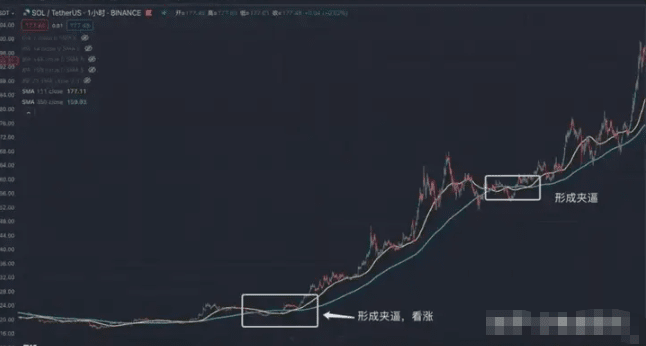
Advanced usage of MACD and MA
Besides the basic usage of MACD and MA, merely knowing these is far from enough. Ultimately, the usage of these technical indicators can be found through public resources. Many main forces and big players will intentionally create "false trends" to make you think that if you don't buy now, it will be too late. In reality, this is just a trick to lure you in.
How to prevent and identify these "false trends"?
False trends mainly guide beginners to enter through MACD golden crosses. Taking the 15-minute trend of BB as an example, when the 15-minute trend breaks a new high, it quickly declines, and MACD turns into a death cross, indicating a pullback begins. However, during the pullback, the trend is rapidly recovering, even approaching the previous high, but at this time, MACD has just started a golden cross. We can interpret this trend as "having the intention but lacking the strength"; the price has rebounded to the previous high, while MACD has just crossed. More than 80% of the time, this trend will resemble the depicted scenario; the strength fades quickly.
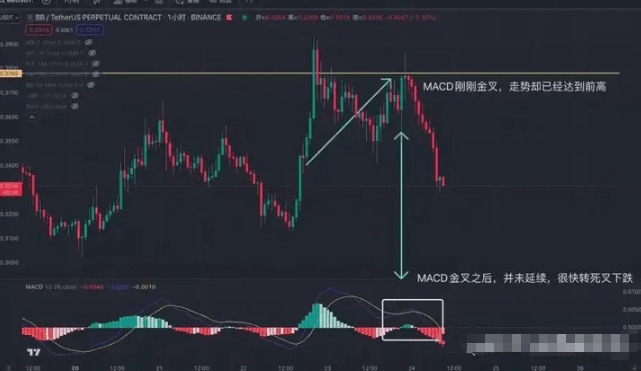
Let’s take the 1-hour trend of ETH as an example: MACD golden cross, green bars rise sharply, and the price follows suit. Such an increase is a sign of quality growth, indicating it is a good time to enter. Then the price enters a horizontal adjustment phase, and MACD turns into a death cross. After adjustment, MACD enters a golden cross, but the increase and trend do not continue as strongly as before. This prolonged state is very dangerous; although MACD has a golden cross, the strength is weak, and the longer this state lasts, the more dangerous it becomes. When the price breaks new highs but MACD does not, we call this "top divergence," which is a strong sell signal. Similarly, when the price breaks new lows but MACD does not, we call this "bottom divergence," which is a buy signal.
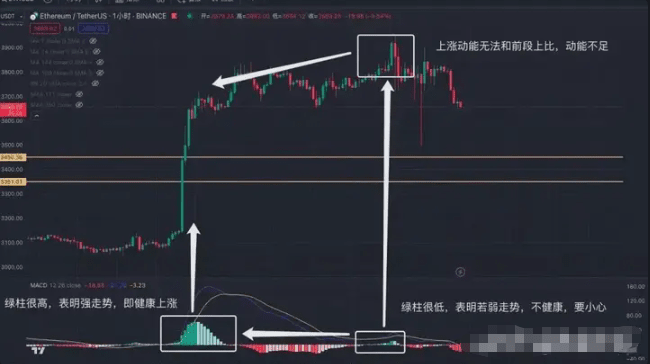
Master the eight key phrases of practical cryptocurrency trading to kickstart your successful journey in the crypto world. Follow the eight little trading tips I share with you, and remember to save them!
1. Supplement positions to seek to preserve capital; hoping for profits is greed.
When trading cryptocurrencies, it is inevitable to have a few coins trapped. At this time, it is crucial to remember not to fantasize about instant recovery from losses; the pursuit of quick gains will only trap you deeper in the mire. You should honestly conduct supplementary buying operations to protect your principal, only then can you achieve a steady flow like a trickling stream.
2. A calm surface can precede a large wave.
The cryptocurrency market appears calm on the surface, but in reality, there are undercurrents. One must not be deceived by the insignificant small increases before them, always maintain high vigilance, and be aware of the potential for severe fluctuations that may occur next.
3. After a significant rise, a pullback is inevitable; K-line often forms a triangle over multiple days.
When the price of cryptocurrencies is soaring, do not let exuberance take over; do not become complacent. Because after such a surge, a pullback is inevitable. Operators need to observe the K-line trend, which is not just a rule drawn over several days into an equilateral triangle.
4. Buy on dips, do not buy on rises; sell on rises, do not sell on dips. Moving against the market is what makes a hero.
When buying cryptocurrencies, decisively enter during a downtrend, and sell when the price is rising. Acting contrarily can lead to unexpected wins, becoming a hero in the cryptocurrency world. 5. Do not sell high, do not buy on dips, and do not trade in a horizontal market.
When the price of cryptocurrencies rises sharply, do not rush to act; when it dips, do not hastily bottom fish. When in a horizontal state, it is even more critical to control your hands and calmly observe, responding to change with stability.
6. Look for support levels in uptrends and resistance levels in downtrends.
When the price of cryptocurrencies is in an upward trend, closely monitor support levels to prevent sudden declines; when the price is declining, pay attention to resistance levels to make decisive bottom-fishing moves at the right time.
7. Full position trading is a major taboo; stubbornness is unwise. One must know when to stop amidst constant changes, entering and exiting freely while observing the market.
Do not engage in full position trading; putting all your eggs in one basket is a poor strategy. The cryptocurrency market is ever-changing, and one must know when to take profits and enter and exit freely. Only by calmly observing the situation can one seize the optimal timing.
8. Trading cryptocurrencies is about mindset; greed and fear are major harms. Be cautious with rises and falls, and remain calm and at ease.
An excellent operator maintains a crucial mindset when operating in the cryptocurrency market. Greed and fear are our greatest enemies; avoid chasing highs and cutting losses. Always maintain a calm and composed mindset, only then can one roam freely in the cryptocurrency world.
Finally, let us firmly remember these eight major operational maxims, and steadily advance in our cryptocurrency journey. The path of trading cryptocurrencies is filled with challenges and opportunities, and these eight practical trading techniques serve as guiding lights along the way. By strictly adhering to 'supplementing positions to seek to preserve capital; hoping for profits is greed,' we can remain calm in difficulties, safeguarding our capital with solid strategies and laying the foundation for future profits.
The martial arts manual has been given to you all; whether or not you can become famous in the community depends on your own efforts.
I am Ah Xin. If you don't know what to do in a bull market, click on my avatar to follow me for spot planning and contract secrets in the bull market, shared free of charge.

